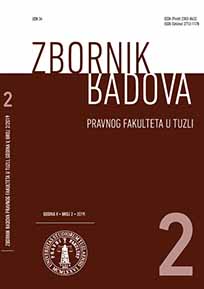OSVRT NA NEKE DIPLOMATIČKE I HISTORIJSKE ASPEKTE POVELJE KULINA BANA
A REVIEW OF SOME DIPLOMATIC AND HISTORICAL ASPECTS OF THE KULIN BAN CHARTER
Author(s): Azem KožarSubject(s): Law, Constitution, Jurisprudence, History of Law, Diplomatic history, 6th to 12th Centuries, Commercial Law
Published by: Pravni fakultet Univerziteta u Tuzli
Keywords: Charter of Kulina Ban; diplomacy; diplomatic document; historical source; Medieval Bosnian state; Hum, rulers; nobles; church; document; historical aspects;
Summary/Abstract: The Charter of Kulin Ban from 1189 is a diplomatic document, characteristic and dominant for the Middle Ages. It talks about making peace between the Bosnian ruler Kulin Ban and Dubrovnik and about giving privileges to Dubrovnik merchants. From the diplomatic point of view, it is a public document issued at the court offices of medieval rulers. It was created, like most other documents in Medieval Bosnia, under the influence of Western diplomacy, which is confirmed by the analysis of its internal and external features. It is made in four copies, two for each contracting party, written in Latin (Caroline-Gothic script) and Cyrillic (bosančica) letter. From the historiographical point of view, the Charter of Kulin Ban is proof that the Medieval Bosnian state also existed and functioned in full capacity in the 12th century. The analysis of the content of this charter and the circumstances in which it was created, both in terms of time and space, and the fact that it is evidence of the full maturity of the medieval Bosnian state and society, provide a broader understanding of the state structure and hierarchy of medieval Bosnia its environment and their mutual economic and diplomatic relations. The special significance of this charter is that it is the oldest preserved historical source of this kind, but the original documents are outside Bosnia and Herzegovina. This fact should be a sufficient civilizational motive for modern Bosnian society and state institutions to begin planning how to establish mechanisms for effective protection of cultural heritage as an unavoidable historical source, and above all as an important segment of their own identity.
Journal: Zbornik radova Pravnog fakulteta u Tuzli
- Issue Year: 5/2019
- Issue No: 2
- Page Range: 7-19
- Page Count: 13
- Language: Bosnian

